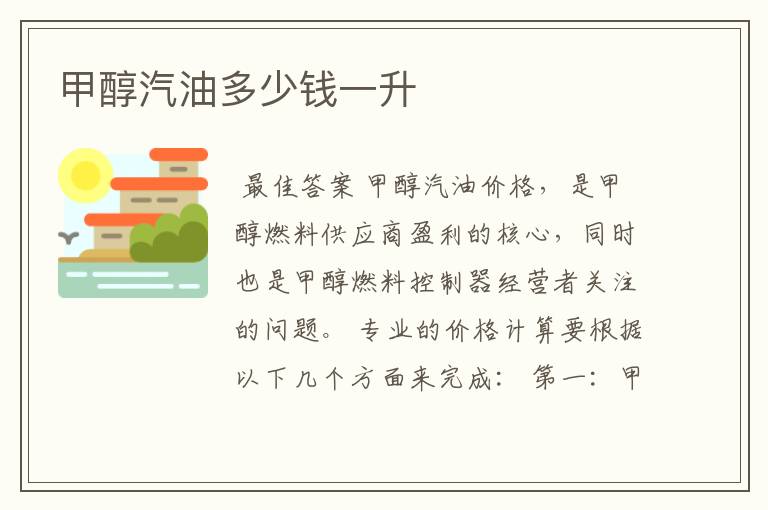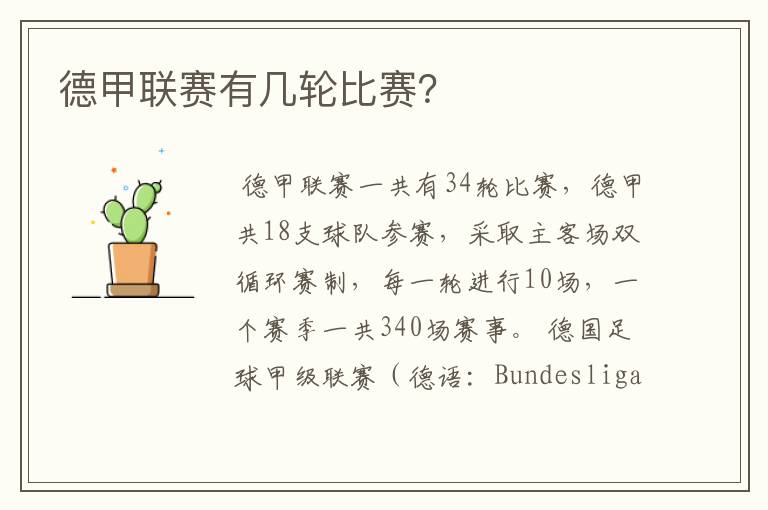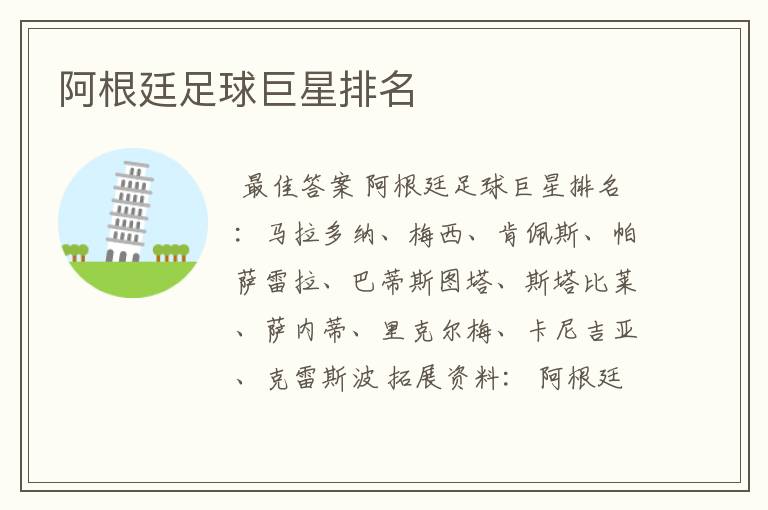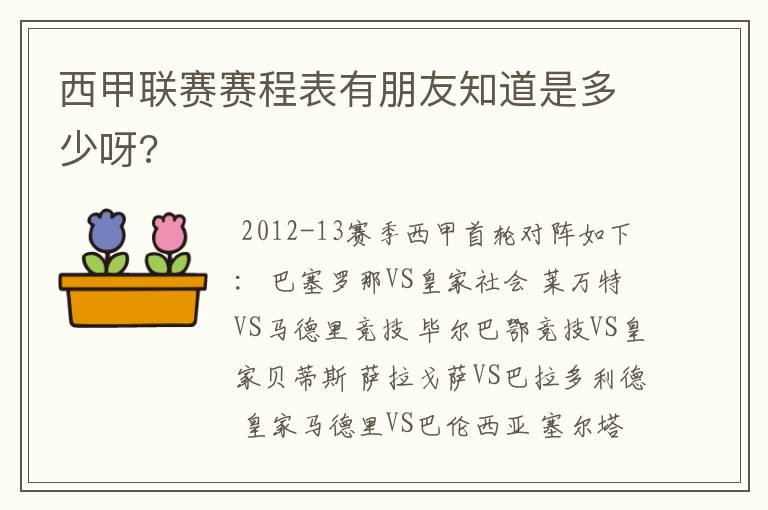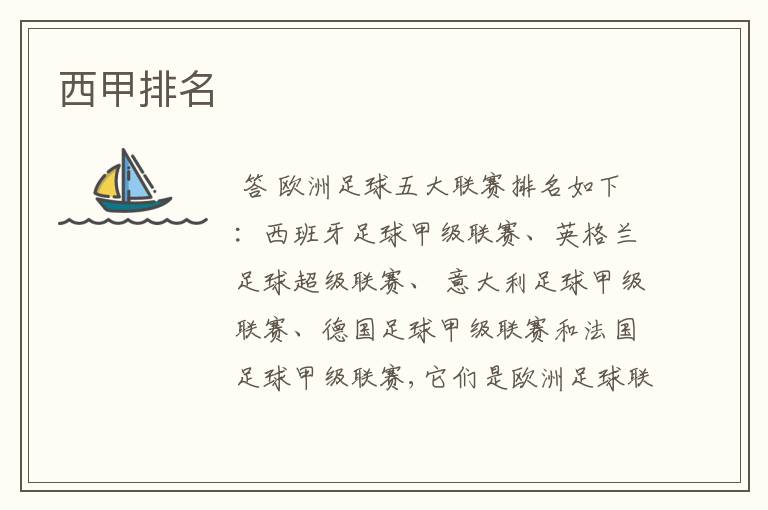北京奥运会吉祥物英语介绍
今天运困体育就给我们广大朋友来聊聊东京奥运会吉祥物,希望能帮助到您找到想要的答案。
关于08奥运的福娃英语简介
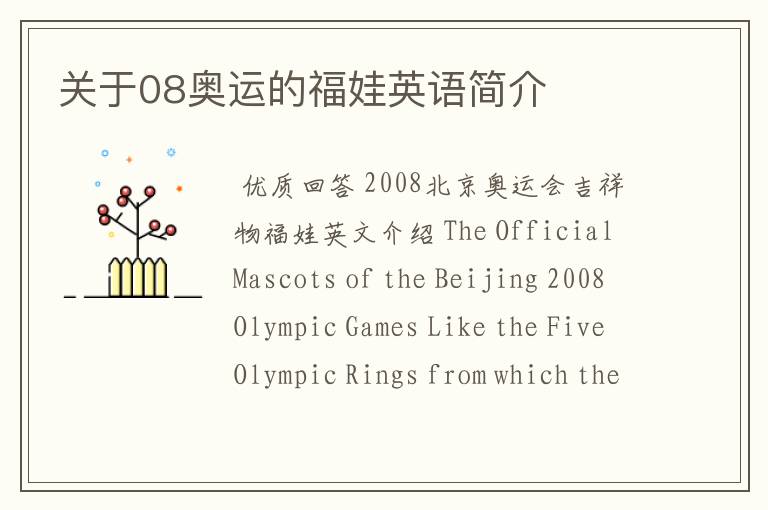
优质回答2008北京奥运会吉祥物福娃英文介绍
The Official Mascots of the Beijing 2008 Olympic Games
Like the Five Olympic Rings from which they draw their color and inspiration, Fuwa will serve as the Official Mascots of Beijing 2008 Olympic Games, carrying a message of friendship and peace--and blessings from China--to children all over the world. Designed to express the playful qualities of five little children who form an intimate circle of friends, Fuwa also embody the natural characteristics of four of China's most popular animals--the Fish, the Panda, the Tibetan Antelope, the Swallow--and the Olympic Flame. Each of Fuwa has a rhyming two-syllable name--a traditional way of expressing affection for children in China. Beibei is the Fish, Jingjing is the Panda, Huanhuan is the Olympic Flame, Yingying is the Tibetan Antelope and Nini is the Swallow. When you put their names together--Bei Jing Huan Ying Ni--they say "Welcome to Beijing," offering a warm invitation that reflects the mission of Fuwa as young ambassadors for the Olympic Games. Fuwa also embody both the landscape and the dreams and aspirations of people from every part of the vast country of China. In their origins and their headpieces, you can see the five elements of nature--the sea, forest, fire, earth and sky--all stylistic rendered in ways that represent the deep traditional influences of Chinese folk art and ornamentation. Spreading Traditional Chinese Blessings Wherever They Go In the ancient culture of China, there is a grand tradition of spreading blessings through signs and symbols. Each of Fuwa symbolizes a different blessing--and will honor this tradition by carrying their blessings to the children of the world. Prosperity, happiness, passion, health and good luck will be spread to every continent as Fuwa carry their invitation to Beijing 2008 to every part of the globe. At the heart of their mission--and through all of their work--Fuwa will seek to unite the world in peace and friendship through the Olympic spirit. Dedicated to helping Beijing 2008 spread its theme of One World, One Dream to every continent, Fuwa reflect the deep desire of the Chinese people to reach out to the world in friendship through the Games--and to invite every man, woman and child to take part in the great celebration of human solidarity that China will host in the light of the flame in 2008.
Like all antelopes, Yingying is fast and agile and can swiftly cover great stretches of land as he races across the earth. A symbol of the vastness of China's landscape, the antelope carries the blessing of health, the strength of body that comes from harmony with nature. Yingying's flying pose captures the essence of a species unique to the Qinghai-Tibet Plateau, one of the first animals put under protection in China. The selection of the Tibetan Antelope reflects Beijing commitment to a Green Olympics. His head ornament incorporates several decorative styles from the Qinghai-Tibet and Sinkiang cultures and the ethnic design traditions of Western China. Strong in track and field events, Yingying is a quick-witted and agile boy who represents the yellow Olympic ring. Every spring and summer, the children of Beijing have flown beautiful kites on the currents of wind that blow through the capital. Among the kite designs, the golden-winged swallow is traditionally one of the most popular. Nini's figure is drawn from this grand tradition of flying designs. Her golden wings symbolize the infinite sky and spread good-luck as a blessing wherever she flies. Swallow is also pronounced "yan" in Chinese, and Yanjing is what Beijing was called as an ancient capital city. Among Fuwa, Nini is as innocent and joyful as a swallow. She is strong in gymnastics and represents the green Olympic ring.
In the intimate circle of Fuwa, Huanhuan is the big brother. He is a child of fire, symbolizing the Olympic Flame and the passion of sport--and passion is the blessing he bestows. Huanhuan stands in the center of Fuwa as the core embodiment of the Olympic spirit. And while he inspires all with the passion to run faster, jump higher and be stronger, he is also open and inviting. Wherever the light of Huanhuan shines, the inviting warmth of Beijing 2008--and the wishful blessings of the Chinese people--can be felt. The firery designs of his head ornament are drawn from the famed Dunhuang murals--with just a touch of China's traditional lucky designs. Huanhuan is outgoing and enthusiastic. He excels at all the ball games and represents the red Olympic ring.
Jingjing makes children smile--and that's why he brings the blessing of happiness wherever he goes. You can see his joy in the charming naivety of his dancing pose and the lovely wave of his black and white fur. As a national treasure and a protected species, pandas are adored by people everywhere. The lotus designs in Jingjing's headdress, which are inspired by the porcelain paintings of the Song Dynasty (A.D.960-1234), symbolize the lush forest and the harmonious relationship between man and nature. Jingjing was chosen to represent our desire to protect nature's gifts--and to preserve the beauty of nature for all generations. Jingjing is charmingly naïve and optimistic. He is an athlete noted for strength who represents the black Olympic ring.
In China's traditional culture and art, the fish and water designs are symbols of prosperity and harvest. And so Beibei carries the blessing of prosperity. A fish is also a symbol of surplus in Chinese culture, another measure of a good year and a good life. The ornamental lines of the water-wave designs are taken from well-known Chinese paintings of the past. Among Fuwa, Beibei is known to be gentle and pure. Strong in water sports, she reflects the blue Olympic ring.
奥运福娃英文介绍
优质回答China is an everyone's court for harmonize, we are living under the environment that dulcify thus, everybody is a happy child.The mascot" the FU WA" of the Olympic game also just represented us this is happy.Innocent child.
The FU WA is be"ed face"" clear and bright"" the NINI" of" the shell shell" by" the HUANHUAN" five be filled with the Chinese race special features of doll constitute.The homophonic of five FU WA name add exactly" Peking is welcome you".This expressed the Chinese people's amity to the people in the world again.The color of the FU WA also acts in cooperation the Olympics at the right moment five yellow turquoise blue of red orange of wreaths, expressed perfect annotation of Olympics to spirit of Olympics of Peking.
The Olympics of 2008 Pekings, the dream of a Chinese, bears in the applause of the world and the tears of the Chinese nations.Be a member of the Chinese nation, I will use the most sincere voice, saying loudly:
" Bless you, belong to China, belong to Peking, belong to our 2008!"
中国是一个和谐的大家庭,我们生活在这样愉悦的环境下,每个人都是幸福的孩子。奥运会的吉祥物“福娃”也正代表了我们这群幸福的.天真的孩子。
福娃是由“欢欢”“迎迎”“贝贝”“晶晶”“妮妮”五个充满中国民族特色的娃娃组成。五个福娃名字的谐音加起来正是“北京欢迎您”。这再一次表达了中国人民对世界人民的友好。福娃的颜色也正好呼应奥运五环红橙黄绿蓝,表现了北京奥运对奥运精神的完美诠释。
2008北京奥运,一个中国人的梦想,在世界的掌声和中华民族的泪水中诞生。身为中华民族的一份子,我将用最真诚的声音,大声说:
“祝福你,属于中国,属于北京,属于我们的2008!”
北京奥运会吉祥物英语介绍是什么?
优质回答北京奥运会吉祥物英语Beijing Olympic mascot。
介绍:
1、Fuwa is the mascot of the 2008 Beijing Olympic Games.
福娃是2008年北京奥运会的吉祥物。
2、Professor Han Meiwa is the designer of Tsinghua University.
福娃设计者是清华大学美术学院教授韩美林老师。
3、Fuwa was officially released on November 11, 2005, just 1000 days before the opening of the 29th Olympic Games.
福娃于2005年11月11日、距离第29届奥运会开幕恰好1000天时正式发布问世。
4、With the hospitality of Beijing, the dolls brought their blessings to all corners of the world and invited people from all countries to gather in Beijing to celebrate the 2008 Olympic ceremony in Beijing, China.
娃娃们带着北京的盛情,将祝福带往世界各个角落,邀请各国人民共聚北京,欢庆中国北京的2008奥运盛典。
5、The five Fuwa are called "Beibei", "Jingjing", "Huanhuan", "Yingying" and "Nini".
五个福娃分别叫“贝贝”、“晶晶”、“欢欢”、“迎迎”、“妮妮”。
2008北京奥运会吉祥物福娃的介绍(英语的)
优质回答Like the Five Olympic Rings from which they draw their color and inspiration, Fuwa will serve as the Official Mascots of Beijing 2008 Olympic Games, carrying a message of friendship and peace -- and good wishes from China -- to children all over the world.
Designed to express the playful qualities of five little children who form an intimate circle of friends, Fuwa also embody the natural characteristics of four of China's most popular animals -- the Fish, the Panda, the Tibetan Antelope, the Swallow -- and the Olympic Flame.
Each of Fuwa has a rhyming two-syllable name -- a traditional way of expressing affection for children in China. Beibei is the Fish, Jingjing is the Panda, Huanhuan is the Olympic Flame, Yingying is the Tibetan Antelope and Nini is the Swallow.
When you put their names together -- Bei Jing Huan Ying Ni -- they say "Welcome to Beijing," offering a warm invitation that reflects the mission of Fuwa as young ambassadors for the Olympic Games.
Fuwa also embody both the landscape and the dreams and aspirations of people from every part of the vast country of China. In their origins and their headpieces, you can see the five elements of nature -- the sea, forest, fire, earth and sky -- all stylistically rendered in ways that represent the deep traditional influences of Chinese folk art and ornamentation.
Spreading Traditional Chinese Good Wishes Wherever They Go
In the ancient culture of China, there is a grand tradition of spreading good wishes through signs and symbols. Each of Fuwa symbolizes a different blessing -- and will honor this tradition by carrying their good wishes to the children of the world. Prosperity, happiness, passion, health and good luck will be spread to every continent as Fuwa carry their invitation to Beijing 2008 to every part of the globe.
At the heart of their mission -- and through all of their work -- Fuwa will seek to unite the world in peace and friendship through the Olympic spirit. Dedicated to helping Beijing 2008 spread its theme of One World, One Dream to every continent, Fuwa reflect the deep desire of the Chinese people to reach out to the world in friendship through the Games -- and to invite every man, woman and child to take part in the great celebration of human solidarity that China will host in the light of the flame in 2008.
冬奥会吉祥物英语介绍是什么?
优质回答冬奥会吉祥物英语介绍:
1、冰墩墩是2022年北京冬季奥运会的吉祥物。
Ice pier is the mascot of the 2022 Beijing Winter Olympic Games.
2、冰墩墩将熊猫形象与富有超能量的冰晶外壳相结合,头部外壳造型取自冰雪运动头盔。
The ice pier pier combines the panda image with the super energy ice crystal shell, and the head shell is taken from the snow sports helmet.
3、冰墩墩装饰彩色光环,整体形象酷似航天员。
Ice pier pier decorated with color aura, the overall image is similar to astronauts.
4、2019年9月17日晚,冰墩墩正式亮相。
On the evening of September 17, 2019, the ice pier pier was officially unveiled.
5、冰墩墩寓意创造非凡、探索未来,体现了追求卓越、引领时代,以及面向未来的无限可能。
Ice pier is meant to create extraordinary and explore the future. It embodies the infinite possibility of pursuing excellence, leading the times and facing the future.
今天的内容先分享到这里了,读完本文《北京奥运会吉祥物英语介绍》之后,是否是您想找的答案呢?想要了解更多,敬请关注www.zuqiumeng.cn,您的关注是给小编最大的鼓励。
本文来自网络,不代表本站立场,转载请注明出处:https://www.zuqiumeng.cn/wenda/1006916.html
